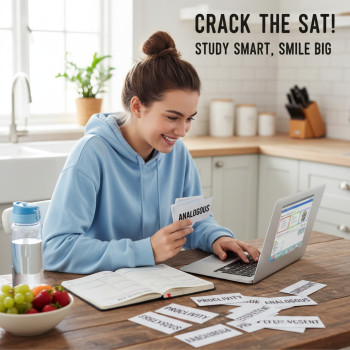Introduction: Why the SAT Still Matters—But Not Alone
If you’re gearing up for college applications, you’ve probably heard the phrase “holistic admissions” a hundred times. It sounds warm and broad—like colleges want the whole story. But what does that actually mean for your Digital SAT score? The short answer: the SAT matters, but it’s one chapter in your complete application narrative.
Think of admissions officers as readers trying to understand who you are, how you’ve grown, and how you might contribute to their campus community. Your SAT is a measurable piece of evidence about academic readiness. Paired with grades, essays, recommendations, extracurriculars, and context (like school resources and life circumstances), it helps paint a fuller picture.
What “Holistic Admissions” Really Looks Like
Holistic admissions means colleges don’t make decisions based on a single data point. Instead, they consider a blend of academic metrics and personal context. Below are the typical categories admissions teams weigh:
- Academic performance: GPA, course rigor (AP, IB, honors), and transcript trends.
- Standardized tests: SAT or ACT scores (when submitted), and sometimes subject tests or AP scores.
- Application essays: Personal voice, reflection, and intellectual curiosity.
- Letters of recommendation: Insights from teachers or mentors about your classroom presence and character.
- Extracurricular activities: Depth, leadership, consistency, and impact.
- Contextual information: Socioeconomic background, school profile, family responsibilities, and any obstacles overcome.
Every college will weigh these pieces differently, but understanding these categories helps you be strategic about where to invest your time.
How Admissions Officers Use SAT Scores in Context
Here’s how SAT scores typically function inside a holistic review:
- Benchmarking academic readiness: Admissions teams use scores to gauge readiness for college-level work alongside GPA and course rigor.
- Comparative tool: When reviewers look at thousands of applications, a test score provides a standardized data point to compare students from different schools and curricula.
- Scholarship and program fit: Some scholarships, honors colleges, or merit-based programs still rely heavily on test scores.
- Supplementary evidence: Test scores can confirm or question other aspects of your application (for example, a high GPA but low test score might lead to questions about grade inflation or access to test prep).
Example: Two Students, Same GPA, Different Contexts
Imagine two students with near-identical GPAs. One attends a well-resourced high school with many AP classes and test-prep opportunities; the other attends a smaller, resource-limited school where AP options are limited. If their SAT scores differ, admissions committees consider school context. A lower SAT from the second student might be weighed differently because the evaluator knows the student had fewer formal resources.
When the SAT Can Make the Biggest Difference
There are specific cases where your SAT score can be especially influential:
- Close decisions: When two applicants are otherwise similar, a higher score can tip the balance.
- Test-optional but score-submitting applicants: If you submit a strong SAT score to a test-optional school, it can bolster your academic narrative.
- Scholarship eligibility: Many merit awards still use SAT cutoffs or ranges.
- Demonstrating recovery: If your transcript shows a dip (due to illness or family issues) but your recent SAT score is strong, it can signal regained momentum.
What Scores Mean—And What They Don’t
An SAT number gives a snapshot of certain academic skills—reading comprehension, problem solving, and math reasoning. It doesn’t precisely measure creativity, character, leadership, or resilience. Because of that, admissions officers avoid letting a single test score define you.
| What the SAT reflects | What the SAT does not reflect |
|---|---|
| Academic readiness and college-level skills | Emotional intelligence and interpersonal skills |
| Performance under timed conditions | Long-term creativity or artistic talent |
| Content knowledge in evidence-based reading and math | Leadership impact or community contributions |
Practical Strategies: How to Use the SAT to Strengthen a Holistic Application
Here are actionable approaches to ensure your SAT helps rather than hurts your narrative.
1. Understand Your Goals—Pick Schools First
Before you obsess over a single score, make a list of target schools and learn their policies. Some are test-optional, some require scores for scholarships, and some superscore (use your highest section scores across test dates). Match your prep timeline to application deadlines so your best score is ready when you apply.
2. Use Score Reports as Diagnostic Tools
Your SAT report offers more than a number; it highlights strengths and weaknesses by section and question type. Use that data to guide study—spend more time on weak areas instead of redoing content you’ve already mastered.
3. Balance Test Prep with Academic Habits
Strong grades and challenging coursework remain the most consistent predictor of college success. Treat SAT prep as a strategic supplement: short, focused practice sessions, regular review of mistakes, and timed practice tests to build stamina and pacing.
4. Tell a Cohesive Story in Your Application
Ask yourself: does my SAT score support the academic parts of my story? If yes, let it be another piece of evidence. If not, explain unusual circumstances in your application (many schools offer optional contextual questions). Use your personal statement or supplemental essays to demonstrate growth, curiosity, and fit.
5. Submit Scores When They Add Value
If you’re applying test-optional, submit a score only if it strengthens your application. A score slightly below the middle 50% for admitted students probably won’t help; a score well within or above that range can bolster your case.
How to Present Context Around Your Score
Admissions officers aren’t just looking at numbers—they want context. Here are ways to provide it:
- School profile: Counselors often submit a school profile that explains grading policies and course offerings.
- Optional space in applications: Use any optional prompts to describe obstacles or responsibilities that limited study time.
- Recommendation letters: A teacher’s note about your dedication or improvement can offset a lower test score.
The Role of Test Prep and Personalized Support
Preparation matters, but it doesn’t look the same for everyone. Personalized tutoring and tailored study plans help students focus efficiently—especially when juggling schoolwork, activities, and family responsibilities. That’s why many students choose help that adapts to their specific strengths and schedules. For example, personalized 1-on-1 guidance, targeted practice, and feedback loops can accelerate improvement without turning prep into a full-time job.
If you’re exploring tutoring, look for programs that offer diagnostic assessments, clear milestones, and strategies for test-day mindset and pacing. Tools that combine experienced tutors with AI-driven insights can highlight patterns in practice tests and suggest precise next steps, making each hour of study more impactful—exactly the efficient kind of preparation that fits into a busy senior year.
Real-World Example: How a Student Leveraged an SAT Score
Consider Maya, a student who attended a high school without AP offerings and worked part-time to support her family. Her GPA was strong—mostly As—but her school’s limited course rigor worried some admissions readers. Maya spent six months working with a tutor on targeted SAT practice, focusing on reading comprehension and algebraic reasoning. Her improved score helped confirm her academic readiness. More importantly, her application highlighted advanced independent projects, a compelling personal essay about balancing responsibilities, and a teacher letter that spoke to her intellectual curiosity. Together, those elements communicated a clear, holistic narrative: Maya was college-ready, resilient, and motivated.
Building a Calendar: When to Test and When to Apply
Timing is key. Here’s a simple timeline to consider:
- Junior year spring: Take a diagnostic SAT to establish baseline and identify weak areas.
- Junior summer to fall: Targeted prep and practice tests; consider a full official Digital SAT when you feel ready.
- Senior year fall: Final test attempts (if needed) to submit the best possible score before application deadlines.
| When | Goal | Actions |
|---|---|---|
| Junior spring | Baseline | Diagnostic test, review score report |
| Junior summer | Focused improvement | Personalized plan, practice tests, build stamina |
| Senior fall | Finalize score | Test-day strategies, submit to colleges that want scores |
How Essays and Recommendations Complement Test Scores
An essay gives you space to speak directly to an admissions reader. If your SAT is a highlight, weave it into your narrative as part of your academic evidence. If it’s not, use the essay to highlight judgment, growth, and passions that tests can’t measure. Recommendations add third-party validation—teachers can contextualize your work ethic and intellectual curiosity in ways a number cannot.
What If My Score Isn’t Where I Want It?
First: breathe. A lower-than-expected SAT doesn’t close doors. There are practical responses you can take:
- Retake the test with a focused plan and realistic timeline.
- Strengthen other parts of your application: essays, portfolio, leadership, and grade improvement.
- Use optional application sections to explain unusual circumstances, briefly and without excuse-making.
- Explore school-specific policies—some put more weight on recent grades or interview impressions.
How to Decide Whether to Submit a Score to Test-Optional Schools
Ask yourself three questions:
- Is this score at or above the middle 50% for admitted students at this college?
- Does this score reinforce my academic story?
- Will submitting the score open scholarship opportunities?
If you answer yes to one or more, sending the score could help. If not, it may be smarter to rely on other strengths.
Putting It All Together: A Short Checklist
- Identify the role the SAT plays at each target college (requirement, optional, or scholarship-based).
- Use score reports diagnostically—target weak areas rather than guessing at a miracle improvement.
- Balance test prep with continued academic rigor and meaningful extracurriculars.
- Tell your story cohesively: essays, recs, and contextual information should all reinforce the same themes.
- Consider targeted support like 1-on-1 tutoring or AI-driven practice to make prep efficient—especially when time is limited.
Image Suggestions
Final Thoughts: The SAT Is a Tool—Not the Whole Story
In the landscape of holistic admissions, the Digital SAT remains useful because it offers a standardized snapshot of certain academic skills. But colleges are trying to discover who you are beyond that snapshot. Your test score is an important data point, not a verdict.
Prioritize balance: maintain strong coursework, craft thoughtful essays, seek recommendations that genuinely reflect your growth, and use the SAT to support your narrative where it makes sense. If you need tailored help, consider personalized tutoring that respects your schedule and strengths—coaching that gives you efficient strategies, clear milestones, and confidence for test day. Programs offering 1-on-1 guidance, tailored study plans, expert tutors, and data-driven insights can be particularly helpful when you want to make every hour of prep count without losing focus on the rest of your application.
Admissions is ultimately about fit. Your goal should be to assemble an application that honestly and compellingly represents who you are—and to let the SAT, when useful, be one more proof point in that compelling story.
Need a Plan? Start Small, Aim Big
Start with a diagnostic test. Make one simple schedule you can keep for six weeks. If you want individualized pacing, consider a short series of 1-on-1 coaching sessions to jump-start progress. Small, consistent improvements add up—and when your whole application comes together, admissions officers will see the pattern of effort, resilience, and intellectual curiosity behind the numbers.
Parting Encouragement
This process can feel overwhelming, but remember: you’re more than one score. Admissions is about people—stories, contexts, and potential. Let the SAT be a helpful tool in your larger effort to tell your story well.
Good luck—and approach each decision with curiosity and calm. You’ve got a whole application of strengths; let them shine.
















No Comments
Leave a comment Cancel